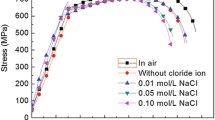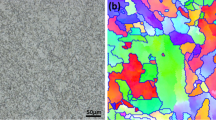Abstract
The relationship between microstructure and alternating current (AC) corrosion behavior of X80 pipeline steel was systematically studied in CO32−/HCO3− solution using corrosion tests and surface analysis technology. The results show that AC prevents the formation of passive film and decreases its stability. AC generates a different damage effect to the passive film on steels with various microstructures. The passive film of normalized microstructure steel has a relatively high stability, followed by the hot-rolled steel, and that of the annealed sample is the most unstable. The influence of AC on passive film of steels with various microstructures causes a difference in the corrosion resistance. The corrosion form of steels with different microstructures applied with AC displays the obvious characteristic of localized corrosion. The normalized microstructure has the optimum corrosion resistance, followed by the hot-rolled steel, and the annealed steel possesses the worst corrosion resistance. The difference in the AC corrosion behavior of X80 steels may be related to the microstructure.












Similar content being viewed by others
References
Y. Hosokawa, F. Kajiyama, and T. Fukuoka, Alternating Current Corrosion Risk Arising from Alternating Current-Powered Rail Transit Systems on Cathodically Protected Buried Steel Pipelines and Its Measures, Corrosion, 2004, 60, p 408–413
S.B. Lalvani and G. Zhang, The Corrosion of Carbon Steel in A Chloride Environment Due to Periodic Voltage Modulation: Part I, Corros. Sci., 1995, 37, p 1567–1582
S.B. Lalvani and G. Zhang, The Corrosion of Carbon Steel in A Chloride Environment Due to Periodic Voltage Modulation: Part II, Corros. Sci., 1995, 37, p 1583–1598
J. Xu, Y.L. Bai, T.Q. Wu, M.C. Yan, C.K. Yun, and C. Sun, Effect of Elastic Stress and Alternating Current on Corrosion of X80 Pipeline Steel in Simulated Soil Solution, Eng. Fail. Anal., 2019, 100, p 192–205
H.X. Wan, D.D. Song, C.W. Du, Z.Y. Liu, and X.G. Li, Effect of Alternating Current and Bacillus Cereus on the Stress Corrosion Behavior and Mechanism of X80 Steel in a Beijing Soil Solution, Bioelectrochemistry, 2019, 127, p 49–58
L.W. Wang, X.H. Wang, Z.Y. Cui, Z.Y. Liu, C.W. Du, and X.G. Li, Effect of Alternating Voltage on Corrosion of X80 and X100 Steels in a Chloride Containing Solution—Investigated by AC Voltammetry Technique, Corros. Sci., 2014, 86, p 213–222
L.Y. Xu, X. Su, and Y.F. Cheng, Effect of Alternating Current on Cathodic Protection on Pipelines, Corros. Sci., 2013, 66, p 263–268
H.R. Wang, C.W. Du, Z.Y. Liu, L.T. Wang, and D. Ding, Effect of Alternating Current on the Cathodic Protection and Interface Structure of X80 Steel, Materials, 2017, 10, p 851–871
L.Y. Xu, X. Su, Z.X. Yin, Y.H. Tang, and Y.F. Cheng, Development of A Real-Time AC/DC Data Acquisition Technique for Studies of AC Corrosion of Pipelines, Corros. Sci., 2012, 61, p 215–223
X.H. Wang, Z.Q. Wang, Y.C. Chen, X.T. Song, and C. Xu, Research on the Corrosion Behavior of X70 Pipeline Steel Under Coupling Effect of AC + DC and Stress, J. Mater. Eng. Perform., 2019, 28, p 1958–1968
A.Q. Fu and Y.F. Cheng, Effects of Alternating Current on Corrosion of A Coated Pipeline Steel in A Chloride-Containing Carbonate/Bicarbonate Solution, Corros. Sci., 2010, 52, p 612–619
Y.B. Guo, T. Meng, D.G. Wang, H. Tan, and R.Y. He, Experimental Research on the Corrosion of X Series Pipeline Steels under Alternating Current Interference, Eng. Fail. Anal., 2017, 78, p 87–98
D. Kuang and Y.F. Cheng, Understand the AC Induced Pitting Corrosion on Pipelines in Both High pH and Neutral pH Carbonate/Bicarbonate Solutions, Corros. Sci., 2014, 85, p 304–310
L.W. Wang, L.J. Cheng, J.R. Li, Z.F. Zhu, S.W. Bai, and Z.Y. Cui, Combined Effect of Alternating Current Interference and Cathodic Protection on Pitting Corrosion and Stress Corrosion Cracking Behavior of X70 Pipeline Steel in Near-Neutral pH Environment, Materials, 2018, 11, p 465–483
M. Zhu, C.W. Du, X.G. Li, Z.Y. Liu, H. Li, and D.W. Zhang, Effect of AC on Stress Corrosion Cracking Behavior and Mechanism of X80 Pipeline Steel in Carbonate/Bicarbonate Solution, Corros. Sci., 2014, 87, p 224–232
M. Zhu, C.W. Du, X.G. Li, Z.Y. Liu, S.R. Wang, J.K. Li, and D.W. Zhang, Effect of AC Current Density on Stress Corrosion Cracking Behavior of X80 Pipeline Steel in High pH Carbonate/Bicarbonate Solution, Electrochim. Acta, 2014, 117, p 351–359
D.T. Chin and S. Venkatesh, A Study of Alternating Voltage Modulation on the Polarization of Mild Steel, J. Electrochem. Soc., 1979, 126, p p1908–p1913
S. Goidanich, L. Lazzari, M. Ormellese, and A.C. Corrosion, Part 2: Parameters Influencing Corrosion Rate, Corros. Sci., 2010, 52, p 916–922
H.Y. Xiao and S.B. Lalvani, A Linear Model of Alternating Voltage-Induced Corrosion, J. Electrochem. Soc., 2008, 155, p C69–C74
M. Yunovich, and N.G. Thompson, AC Corrosion: Mechanism and Proposed Model Proceedings of IPC (International Pipeline Conference) 2004. Paper 0574. ASME International, Calgary; 2004 (IPC 2004. Paper no. 0574, ASME, Calgary, 2004)
S.B. Lalvani and X. Lin, A Theoretical Approach for Predicting AC-Induced Corrosion, Corros. Sci., 1994, 36, p 1039–1046
S.B. Lalvani and X. Lin, A Revised Model for Predicting Corrosion of Materials Induced by Alternating Voltages, Corros. Sci., 1996, 38, p 1709–1719
S. Goidanich, L. Lazzari, M. Ormellese, and A.C. Corrosion, Part 1: Effects on Overpotentials of Anodic and Cathodic Processes, Corros. Sci., 2010, 52, p 491–497
U. Bertocci, AC Induced Corrosion: The Effect of an Alternating Voltage on Electrodes Under Charge-Transfer Control, Corrosion, 1979, 35, p 211–215
J.Y. Zhu, L.N. Xu, Z.C. Feng, G.S. Frankel, M.X. Lu, and W.C. Chang, Galvanic Corrosion of a Welded Joint in 3Cr Low Alloy Pipeline Steel, Corros. Sci., 2016, 111, p 391–403
Q. Qiao, G.X. Cheng, W. Wu, Y. Li, H. Huang, and Z.F. Wei, Failure Analysis of Corrosion at an Inhomogeneous Welded Joint in a Natural Gas Gathering Pipeline Considering the Combined Action of Multiple Factors, Eng. Fail. Anal., 2016, 64, p 126–143
S. Bordbar, M. Alizadeh, and S.H. Hashemi, Effects of Microstructure Alteration on Corrosion Behavior of Welded Joint in API, X70 Pipeline Steel, Mater. Des., 2013, 45, p 597–604
V.A. Alves and C.M.A. Brett, Characterization of Passive Films Formed on Mild Steels in Bicarbonate Solution by EIS, Electrochim. Acta, 2002, 47, p 2081–2091
J. Sikora, E. Sikora, and D.D. Macdonald, Electronic Structure of the Passive Film on Tungsten, Electrochim. Acta, 2000, 45, p 1875–1883
C.A. Gercasi, M.E. Folquer, A.E. Vallejo, and P.E. Alvarez, Electron Transfer Across Anodic Films Formed on Tin in Carbonate-Bicarbonate Buffer Solution, Electrochim. Acta, 2005, 50, p 1113–1119
P. Schmuki and H. Bohni, Illumination Effects on the Stability of the Passive Film on Iron, Electrochim. Acta, 1995, 40, p 775–783
W.S. Li and J.L. Luo, Uniformity of Passive Films Formed on Ferrite and Martensite by Different Inorganic Inhibitors, Corros. Sci., 2002, 44, p p1695–p1712
A. Goossens, M. Vazquez, and D.D. Macdonald, The Nature of Electronic States in Anodic Zirconium Oxide Films Part 1: The Potential Distribution, Electrochim. Acta, 1996, 41, p 35–45
S. Ningshen, U. Kamachimudali, V. Mittal, and H. Khatak, Semiconducting and Passive Film Properties of Nitrogen-Containing Type 316LN Stainless Steels, Corros. Sci., 2007, 49, p 481–496
C. Sunseri, S. Piazza, and F. Quarto, Photocurrent Spectroscopic Investigations of Passive Films on Chromium, J. Electrochem. Soc., 1990, 137, p 2411–2417
H. Luo, C.F. Dong, X.G. Li, and K. Xiao, The Electrochemical Behaviour of 2205 Duplex Stainless Steel in Alkaline Solutions with Different pH in the Presence of Chloride, Electrochim. Acta, 2012, 64, p 211–220
H. Luo, C.F. Dong, K. Xiao, and X.G. Li, Characterization of Passive Film on 2205 Duplex Stainless Steel in Sodium Thiosulphate Solution, Appl. Surf. Sci., 2011, 258, p 631–639
K. Jüttner, Electrochemical Impedance Spectroscopy (EIS) of Corrosion Processes on Inhomogeneous Surfaces, Electrochim. Acta, 1990, 35, p 1501–1508
D.J. Blackwood, Influence of the Space-Charge Region on Electrochemical Impedance Measurements on Passive Oxide Films on Titanium, Electrochim. Acta, 2000, 46, p 563–569
L.W. Wang, C.W. Du, Z.Y. Liu, X.H. Wang, and X.G. Li, Influence of Carbon on Stress Corrosion Cracking of High Strength Pipeline Steel, Corros. Sci., 2013, 76, p 486–493
D. Clover, B. Kinsella, B. Pejcic, and R. Marco, The Influence of Microstructure on the Corrosion Rate of Various Carbon Steels, J. Appl. Electrochem., 2005, 35, p 139–149
H.J. Cleary and N.D. Greene, Electrochemical Properties of Fe and Steel, Corros. Sci., 1969, 9, p 3–13
D.N. Staicopolus, The Role of Cementite in the Acidic Corrosion of Steel, J. Electrochem. Soc., 1963, 110, p 1121–1124
Y.P. Wang, X.R. Zuo, and J.L. Li, Corrosion Resistance of the Welded Joint of Submarine Pipeline Steel with Ferrite Plus Bainite Dual-Phase Microstructure, Steel Res. Int., 2015, 86, p 1260–1270
G. Ma, X.R. Zuo, L. Hong, Y.L. Ji, J.Y. Dong, and H.H. Wang, Investigation of Corrosion Behavior of Welded Joint of X70 Pipeline Steel for Deep Sea, Acta Metall. Sin., 2018, 54, p 527–536
F. Mohammadi, F.F. Eliyan, and A. Alfantazi, Corrosion of Simulated Weld HAZ of API, X80 Pipeline Steel, Corros. Sci., 2012, 63, p 323–333
Acknowledgments
This work was supported by the National Natural Science Foundation of China, the Natural Science Foundation of Zhejiang Province (No. LY18E010004), and the National R&D Infrastructure and Facility Development Program of China (No. 2005DKA10400).
Author information
Authors and Affiliations
Corresponding author
Additional information
Publisher's Note
Springer Nature remains neutral with regard to jurisdictional claims in published maps and institutional affiliations.
Rights and permissions
About this article
Cite this article
Zhu, M., Yang, J.L., Chen, Y.B. et al. Effect of Alternating Current on Passive Film and Corrosion Behavior of Pipeline Steel with Different Microstructures in Carbonate/Bicarbonate Solution. J. of Materi Eng and Perform 29, 423–433 (2020). https://doi.org/10.1007/s11665-019-04541-x
Received:
Revised:
Published:
Issue Date:
DOI: https://doi.org/10.1007/s11665-019-04541-x




